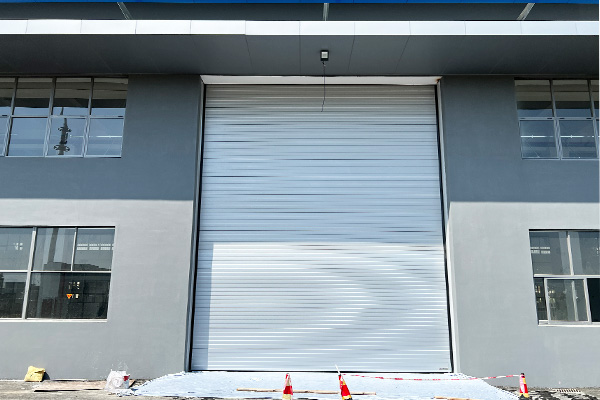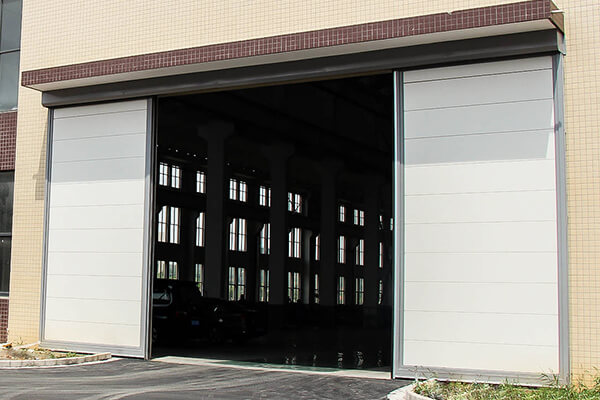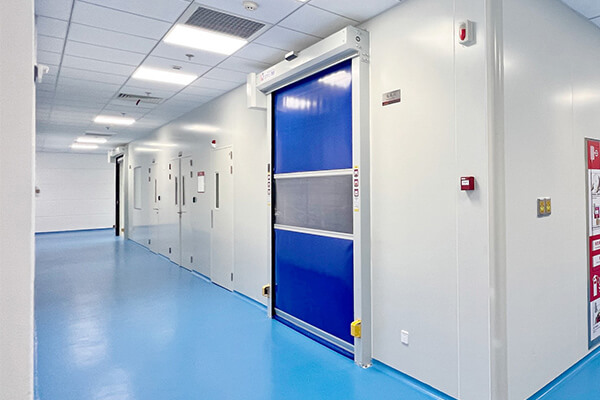When planning or upgrading your workshop, choosing the right workshop entrance door is an important decision that has a direct impact on the efficiency of daily operations, energy costs and safety. An unsuitable door can lead to unnecessary energy loss or malfunctions in use, which can affect production schedules. This guide will provide you with a clear framework for decision making. It outlines the 5 core factors that must be systematically evaluated before selecting a workshop entrance door to ensure the industrial door solutions you choose truly matches and optimizes your workflow.
Contents
Factor 1: Operational Efficiency & Opening Speed
When evaluating a SEPPES workshop entrance door, the first consideration should be how well it matches the pace of your work. You can start by answering this central question:” How often do people and equipment (e.g. forklifts, carts) pass through your workshop each day?” The answer to this question will directly determine which door type you should focus on.
Different door types for very different purposes and scenarios, and the opening speed is one of the most significant differences between them.
Technical details: Comparison of the speeds of different door types
High-Speed Workshop Doors

Speed: Typically between 0.8-1.5 m/s.
Scenario: Ideal for high-frequency, fast-paced passageways. For example, internal logistics corridors connecting production areas with warehouses and busy loading/unloading zones. Its core advantage is that it minimizes the waiting time for the door to open, ensuring that forklift trucks and personnel can pass through seamlessly and continuously, avoiding congestion.
Sectional Doors

Speed: Slower opening speeds, typically around 0.2 m/s – 0.4 m/s.
Scenarios: Due to their robust panel construction and excellent sealing and insulation properties, sectional lifting door are ideally suit ed for use as exterior doors on buildings, such as main doors in warehouses with infrequent traffic or loading docks. In these scenarios, the need for security and insulation takes precedence over speed.
Commercial Roller Shutter Doors

Speed: Similar to sectional door, slower speeds, typically in the range of 0.2 m/s – 0.3 m/s.
Scenarios: Mainly used for external openings with high security and anti-theft requirements. But which are not opened very often on a daily basis, e.g. warehouse doors that are closed at night.
Industrial Sliding Doors

Speed: Wide range of speeds, but usually in the low to medium range.
Scenarios: Suitable for doorways with enough space on the side of the doorway, commonly found in some large equipment workshops or airplane hangars.
| Workshop Door Type | Speed Rating | Efficiency Rating | Best Use-Case Scenario |
| High-Speed Roll-Up Door | ★★★★★ | ★★★★★ | Internal high-frequency logistics, fast-paced production lines, areas requiring environmental control. |
| Sectional Door | ★★☆☆☆ | ★★☆☆☆ | External warehouse doors and loading docks, with lower traffic frequency but higher insulation and security requirements. |
| Commercial Roller Shutter Door | ★☆☆☆☆ | ★☆☆☆☆ | External openings with high security demands, closed at night or for long periods, with minimal daily opening frequency. |
| Sliding Door | ★★★☆☆ | ★★★☆☆ | Large workshops with ample side space for door openings, suitable for oversized openings. |
Comparative of Four Mainstream Workshop Doors
Choosing the right workshop entrance door requires a comprehensive assessment of its performance throughout its life. The table below provides an in-depth comparison of high-speed doors, sectional overhead doors, commercial roll-up doors and sliding doors in terms of multiple dimensions such as mode of operation, cost, space utilization, durability and safety, as well as maintenance and replacement.
| Comparison Aspect | High-Speed Roll Up Door | Sectional Door | Roller Shutter Door | Sliding Door |
| Operation Method | Highly automated. Can work with radar, geomagnetic, remote control and other kinds of sensors to realize automatic and fast opening. | Mostly electric button control. Remote control is also available as an option, but usually does not work with automatic sensors, as it is slower. | Motorized or manual chains. Usually not suitable for automated high frequency opening due to its weight and speed. | Mostly motorized push button or remote control. The degree of automation is between sectional and high-speed doors due to their lateral movement. |
| Installation & Maintenance Cost | Moderate installation cost and low maintenance cost. In particular, the direct-drive motor type has no wearing parts (e.g., springs) and has the lowest long-term maintenance costs. | Moderate installation cost, high maintenance cost. Torsion springs are the core wearing parts and need to be checked, adjusted or even replaced periodically. | Low installation cost, medium maintenance cost. Door curtain sheets, springs and motors all require regular maintenance. | Higher installation costs. Requires precise floor or top track laying and high floor leveling requirements. Medium maintenance costs. |
| Space Utilization | The curtain is rolled vertically upwards into the casing, taking up hardly any effective space on the sides and top of the doorway. | Door panels that go up along the track and turn to be placed horizontally below the ceiling take up ceiling space above the doorway. | Similar to high-speed doors, the door curtain is rolled vertically into the casing, taking up no space on either side. | Low. It is necessary to reserve a wall space the same width as the door opening on one or both sides of the door opening for parking when the door is open. |
| Durability & Safety | High durability and top security. Infrared safety photoelectric as standard. | Good durability and safety standards. Sturdy hard door panels are impact resistant. Safety devices are usually bottom airbags or single point photoelectric eyes. | Durability depends on the material, security base. The main function is anti-theft. Safety features are usually fewer and require additional options. | High durability and good security. The robust door body and track system is very durable. The safety devices are similar to sectional doors and need to prevent the risk of entrapment. |
| Maintenance & Replacement | Simple maintenance and easy parts replacement. | Highly specialized maintenance. | The door curtain sheet can be replaced by single piece if it is damaged. However, if the roll shaft or motor is out of order, the maintenance is more complicated. | The track needs to be kept clean and free of obstacles. Overhaul of the door body or drive system is more expensive to replace. |
Factor 2: Safety Features & Compliance
In any workshop filled with personnel and mobile equipment, the safety of the workshop door is crucial. Therefore, the second core question you should ask when selecting a workshop entrance door is: “What safety features are equipped to ensure the absolute safety of both personnel and equipment passing through the door?” A modern workshop door should have a comprehensive safety system.
Infrared Safety Photoelectric
Working Principle: This is the most basic safety feature. A pair of emitters and receivers installed approximately 30-50 cm above the ground on both sides of the door opening, forming an invisible infrared beam. When the door is descending, if any object blocks this beam, the door will immediately stop descending and reverse its motion.
Limitations: Its protection is limited to a “line.” It cannot detect obstacles above or below this line (e.g., forklift prongs), leaving a noticeable safety blind spot.
Light Curtains
Working Principle: This is currently the highest-level safety technology in the industrial door field. It also installs emitters and receivers on both sides of the door opening, but it integrates dozens or even hundreds of miniature infrared emitters and receivers, extending from the ground up to nearly 2 meters high, forming a dense, invisible infrared curtain.
Advantages: Unlike the “line” protection of infrared photoelectric systems, light curtains provide “area” protection. Compared with the traditional single-point photoelectric, the safety light curtain eliminates almost all the detection blind zones. And can effectively prevent the door from dropping down and injuring people or impacting goods, providing the highest level of security.
Anti-Pinch Design
Applicable to: Mainly for sectional doors.
Design Details: The profiles at the joints of the door panels are specially designed with curved or beveled edges. When the door folds at the corners, the gap between the panels does not form sharp angles that could pinch fingers, effectively preventing accidents when operators are in close proximity to the door.
Emergency Stop & Warning Systems
Necessity: These are essential configurations for all power-driven doors. An easily accessible red emergency stop button must be installed near the door control box or the door itself, allowing anyone to immediately cut off the power in an emergency.
Warning System: Paired with a warning light and siren, it can emit signals before the door starts, alerting nearby personnel, especially in noisy or obstructed-vision environments.

Factor 3: Durability & Maintenance Costs
A workshop entrance door is a product that needs to be used for a long time in the overall workshop. Therefore, the third central question concerns its long-term stability and economy: “Will this door function reliably in my workshop environment over the long term and minimize subsequent expenses?” Durability does not just mean robustness; it is a comprehensive concept that encompasses materials, structural design and drive systems.
Technical details: key factors for long-term performance
- Material Selection: The main material of the door body directly determines its adaptability to the environment of your workshop.
- Galvanized Steel: This is the most common material used for sectional liftgates and traditional rolling doors. It has good strength and low cost, and is galvanized to provide some resistance to rust. However, in a continuously humid or chemically corrosive environment, rust will spread rapidly once the rust-resistant layer is scratched.
- Aluminum Alloy: Lightweight, naturally rust-resistant, modern in appearance. Commonly used in mixed commercial/industrial environments where clear windows or aesthetics are desired. It is less impact resistant than steel.
- Stainless Steel: This is the gold standard for corrosion resistance, especially in food processing, pharmaceutical or chemical plants where hygiene and corrosion resistance are paramount. Although it has the highest initial cost, its long service life and very low maintenance requirements make it the best investment for harsh environments.
- PVC/Fabric: This is the signature material for high-speed roll up doors. A high-strength polyester fiber base fabric with a PVC coating makes it both flexible and strong. Not only is it completely rust-resistant, but it also has excellent tear resistance and self-healing properties.
Drive System
Conventional Drive (Spring + Chain/Belt): Most sectional lifting and roll-up doors rely on torsion springs to counterbalance the weight of the door, which is then driven by a motor via a chain. The biggest disadvantage of this system is that torsion springs are high-strength wearing parts that suffer from metal fatigue under frequent use and require regular adjustment, lubrication, and eventual replacement, which is an unavoidable maintenance expense.
Direct-Drive Motor: This is an advanced technology commonly used in modern high-speed doors. It essentially eliminates springs and chains, with the motor acting directly on the spool in an extremely simplified structure. This means that there are virtually no mechanical wear parts and the failure rate is minimized. The design is more responsive and smoother running.
Factor 4: Energy Efficiency & Environmental Control
In addition to passage efficiency and safety, a workshop entrance door plays a crucial role in maintaining a stable internal environment within the workshop. Therefore, the fourth core question is: “Do you need to maintain stable temperature, humidity, or cleanliness inside the workshop?”
If your workshop requires a stable temperature, or if you are in industries with strict environmental requirements such as food, pharmaceuticals, or precision electronics, then the industrial door in your workshop will affect your operations and product quality. An energy efficient industrial door primarily controls the environment through two main aspects:
Sealing Performance
- Design Principle: Preventing air infiltration is the first step in energy efficiency. A well-designed door creates an almost airtight space when closed. This requires a complete, all-around sealing system:
- Side Seals: Inside the two side tracks, durable brush seals or multi-layer EPDM rubber seals are typically embedded to ensure there are no gaps between the door edges and tracks.
- Top Seal: When the door is fully closed, the seal above the door aligns tightly with the top of the door panel.
- Bottom Seal: The bottom of the door is equipped with thick, flexible rubber seals that adapt to slightly uneven floors, filling any gaps between the door and the ground.
- Effect: This system effectively prevents unfiltered air, dust, moisture, and insects from entering the workshop while stopping controlled air (heated/cooled air) from leaking out.
Insulation Performance
Direct Insulation (for hard doors): For sectional doors, the energy-saving effect mainly comes from the insulation capacity of the door panels themselves. A high-quality insulated workshop door is filled with high-density polyurethane foam between dual steel plates. Its insulation performance is typically measured using the R-value, with a higher R-value indicating greater resistance to heat penetration and better thermal insulation.
Indirect Insulation (for high-speed doors): The energy-saving logic for high-speed doors is different. While the R-value of the flexible door curtain is not high, it reduces the time the door opening remains exposed by 80% or more with its rapid opening and closing action. This minimizes the time for air exchange between the interior and exterior. For doors with frequent passage, this approach is more effective than using a thick, insulated door that remains open for long periods.

Factor 5: Initial Investment & Long-Term ROI
After evaluating the first four factors, we come to the final decision. This is the most important question for all managers, “What should my budget be? How do I assess the true value of this investment?”
In this section, we’ll bring all the factors discussed earlier – efficiency, safety, durability, and energy efficiency – together to provide you with a clear framework for decision-making.
| Evaluation Factor | Your Priority Score, 1-5 | High-Speed Door | Sectional Door | Roller Shutter |
| Efficiency | [Enter your score here] | ★★★★★ | ★★☆☆☆ | ★☆☆☆☆ |
| Safety | [Enter your score here] | ★★★★★ | ★★★☆☆ | ★★☆☆☆ |
| Durability | [Enter your score here] | ★★★★★ | ★★★☆☆ | ★★★☆☆ |
| Energy Saving | [Enter your score here] | ★★★★☆ | ★★★★☆ | ★★☆☆☆ |
| Space Utilization | [Enter your score here] | ★★★★★ | ★★★☆☆ | ★★★★★ |
In summary, the workshop entrance door is an important part of workshop design. It requires a combination of access efficiency, safety, long-term durability, energy efficiency and total cost of ownership. The right choice can increase your productivity and reduce operating costs.
This article was written by the SEPPES industrial door team of experts. As a solutions provider with over a decade of experience in industrial doors, we have provided efficient and secure entrance solutions to over 4,200 manufacturing companies, logistics centers and factories across a wide range of industries. Our experience is a guarantee of your trust.




